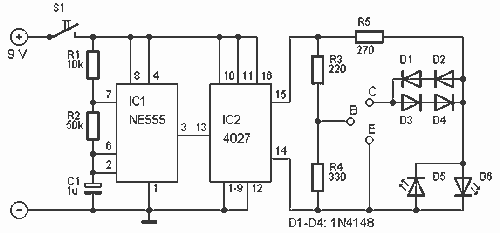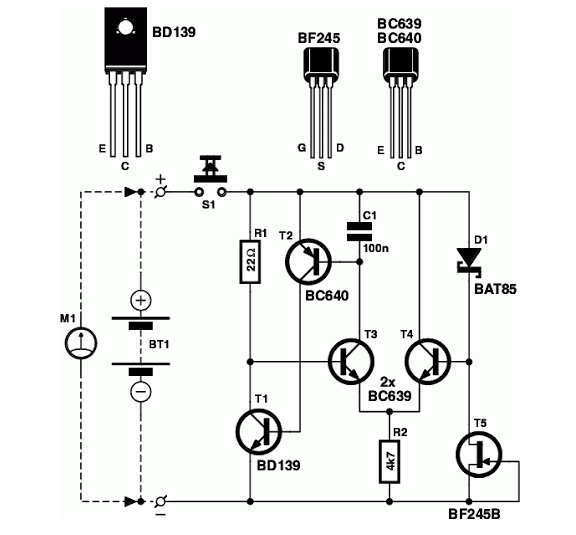
Fire Alarm schematic design

This document outlines a basic fire alarm circuit utilizing an LDR (Light Dependent Resistor) for fire detection. The circuit is designed to generate an audible alarm in response to smoke, which affects the LDR's resistance. In the absence of smoke, the LDR maintains a low resistance, resulting in a voltage drop of less than 0.6 V, preventing transistor activation. When smoke is present, the LDR's resistance increases, causing the transistor to turn on. The circuit is powered by a 5V supply, which operates a tone generator IC (UM66) that produces sound through an amplifier (TDA2002) to drive a speaker. Resistors R4 and R6 provide protection against low resistance values in the transistor. Resistors R1 and R2 are used for feedback in the TDA2002, while capacitors and diodes regulate the voltage and feedback signals. The circuit can be powered by a 9V battery or DC power supply and can utilize a 1K resistor in series with a bright LED instead of a bulb.
The fire alarm circuit employs an LDR as the primary sensor for smoke detection. The operation begins with the LDR exposed to light, maintaining a low resistance and a voltage output that keeps the transistor in an off state. When smoke enters the detection area, it obscures the light reaching the LDR, leading to an increase in resistance. This change in resistance causes the voltage across the LDR to rise above the threshold necessary to activate the transistor.
The transistor's activation allows current to flow to the tone generator IC (UM66), which is responsible for generating the alarm sound. The UM66 is designed to operate within a specific voltage range; therefore, diodes D1 and D2 are included to ensure the voltage does not exceed the rated maximum of 3.5V, as the UM66 requires at least 4V to function properly.
The audio signal produced by the UM66 is then amplified by the TDA2002, which drives a speaker to output the alarm sound. The circuit includes potentiometers R3 and R4, which allow for adjustments in the volume of the alarm and the sensitivity of the smoke detection, respectively. The use of general-purpose NPN transistors such as BC548, BC148, or 2N222 ensures compatibility and availability for the circuit.
The circuit can be powered by either a 9V battery or a 9V DC power supply, providing flexibility in application. Additionally, the option to use a 1K resistor in series with a bright LED instead of a traditional bulb offers a modern alternative for visual indicators in the alarm system. This design emphasizes simplicity and effectiveness in smoke detection and alarm generation, making it suitable for various applications.Explanation Here is a simple fire alarm circuit based on an LDR fire detection sensor. Smoke generated during circuit generates an audible alarm, fire smoke in case of fire. Al arm works and lamp pairs. When there is no smoke from the light bulb will directly LDR.The decline LDR resistance is low, the voltage across it (less than 0.6 V). Transistors will not have enough smoke happens.When shield falls LDR, LDR resistance increases, so the whole it.Now voltage transistor switching to ON.This to IC1 power, it 5V.This power output tone generator IC UM66 ( IC2) by the IC3 2002 (TDA), play music.This music will be amplified to drive speaker.Resistor R6 is R4 is open protected against low resistance value of the transistor means.
resistors R1 and R2 for the TDA2002 feedback web forms, C1 couples from R1 and R2 are the same at the junction of the inverting input of IC feedback signal. Diodes D1 and D2 binding, down to 1.V rated voltage (3.5V) UM66. The UM 66 can not afford less than 4V. Circuit diagram and parts list Fire alarm circuit Precautions 32 speaker may be a tweeter. R4 potentiometer can be used to adjust the sensitivity of the alarm. Potentiometer R3 may be used for different alert volume. The first quarter may be used for any general purpose NPN transistor (such as BC548, BC148,2N222). The circuit can be from 9V battery or a 9V DC power supply. Instead bulb can use a 1K resistor series bright LED.
The fire alarm circuit employs an LDR as the primary sensor for smoke detection. The operation begins with the LDR exposed to light, maintaining a low resistance and a voltage output that keeps the transistor in an off state. When smoke enters the detection area, it obscures the light reaching the LDR, leading to an increase in resistance. This change in resistance causes the voltage across the LDR to rise above the threshold necessary to activate the transistor.
The transistor's activation allows current to flow to the tone generator IC (UM66), which is responsible for generating the alarm sound. The UM66 is designed to operate within a specific voltage range; therefore, diodes D1 and D2 are included to ensure the voltage does not exceed the rated maximum of 3.5V, as the UM66 requires at least 4V to function properly.
The audio signal produced by the UM66 is then amplified by the TDA2002, which drives a speaker to output the alarm sound. The circuit includes potentiometers R3 and R4, which allow for adjustments in the volume of the alarm and the sensitivity of the smoke detection, respectively. The use of general-purpose NPN transistors such as BC548, BC148, or 2N222 ensures compatibility and availability for the circuit.
The circuit can be powered by either a 9V battery or a 9V DC power supply, providing flexibility in application. Additionally, the option to use a 1K resistor in series with a bright LED instead of a traditional bulb offers a modern alternative for visual indicators in the alarm system. This design emphasizes simplicity and effectiveness in smoke detection and alarm generation, making it suitable for various applications.Explanation Here is a simple fire alarm circuit based on an LDR fire detection sensor. Smoke generated during circuit generates an audible alarm, fire smoke in case of fire. Al arm works and lamp pairs. When there is no smoke from the light bulb will directly LDR.The decline LDR resistance is low, the voltage across it (less than 0.6 V). Transistors will not have enough smoke happens.When shield falls LDR, LDR resistance increases, so the whole it.Now voltage transistor switching to ON.This to IC1 power, it 5V.This power output tone generator IC UM66 ( IC2) by the IC3 2002 (TDA), play music.This music will be amplified to drive speaker.Resistor R6 is R4 is open protected against low resistance value of the transistor means.
resistors R1 and R2 for the TDA2002 feedback web forms, C1 couples from R1 and R2 are the same at the junction of the inverting input of IC feedback signal. Diodes D1 and D2 binding, down to 1.V rated voltage (3.5V) UM66. The UM 66 can not afford less than 4V. Circuit diagram and parts list Fire alarm circuit Precautions 32 speaker may be a tweeter. R4 potentiometer can be used to adjust the sensitivity of the alarm. Potentiometer R3 may be used for different alert volume. The first quarter may be used for any general purpose NPN transistor (such as BC548, BC148,2N222). The circuit can be from 9V battery or a 9V DC power supply. Instead bulb can use a 1K resistor series bright LED.





